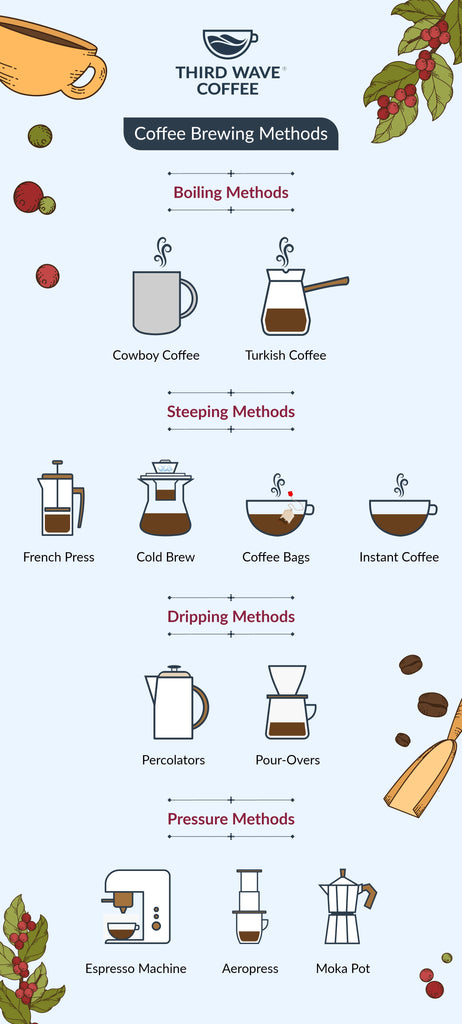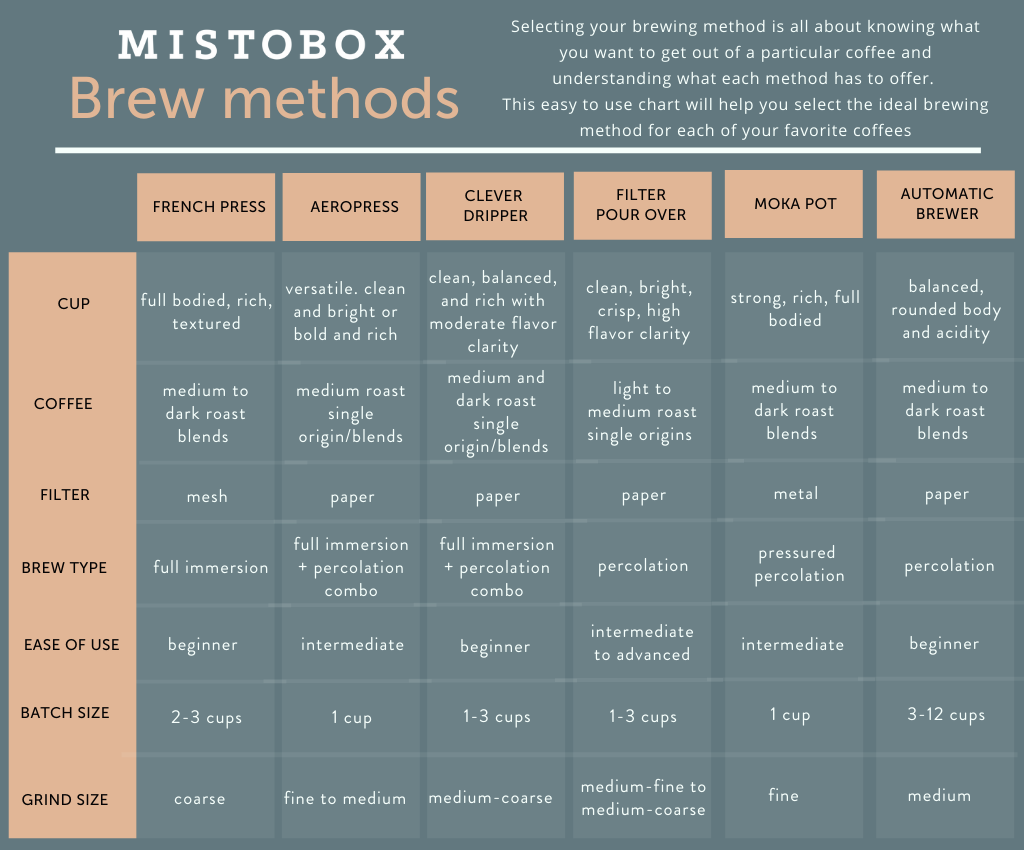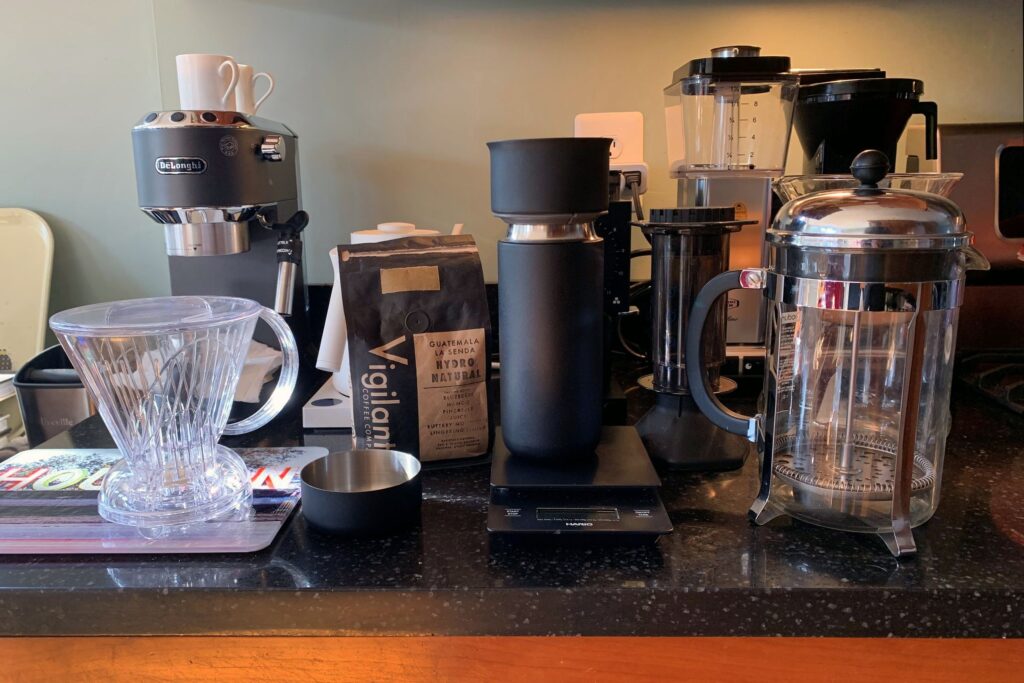
In this article, you will explore the pros and cons of various coffee brewing methods. Whether you’re a coffee connoisseur or simply looking to enhance your morning routine, understanding the different techniques can help you make the perfect cup of joe. From the classic French press to the trendy pour-over, we will examine the advantages and disadvantages of each method, allowing you to discover the best way to brew your favorite beverage. So grab a fresh cup of coffee and let’s embark on this flavorful journey together!

This image is property of cdn.shopify.com.
1. Drip Coffee
1.1 Ease of use
Drip coffee is one of the most popular methods of brewing coffee, and for good reason. It is incredibly easy to use, making it a great choice for those who are new to making their own coffee at home. All you need is a drip coffee maker and some ground coffee, and you’re ready to go. Simply add water, put in the coffee grounds, and press the start button. The machine will do all the work for you, brewing a delicious pot of coffee in no time.
1.2 Consistency of flavor
One of the benefits of drip coffee is the consistency of flavor that it provides. Since the water is poured over the coffee grounds evenly and consistently, you can expect each cup to taste just as good as the last. This is especially important for those who like to enjoy their coffee on a daily basis and are looking for a reliable method to achieve a consistent and satisfying flavor.
1.3 Brewing time
Another advantage of drip coffee is the relatively short brewing time. It typically takes around 5 to 10 minutes for a pot of drip coffee to brew, depending on the size of the machine and the amount of coffee you’re making. This makes it a convenient option for those who are on a tight schedule in the mornings and need their coffee quickly.
2. French Press
2.1 Rich and robust flavors
If you’re someone who enjoys a rich and robust cup of coffee, then the French press method might be for you. The immersion brewing process used in a French press allows the coffee grounds to steep in hot water for a longer period of time, resulting in a bold and flavorful brew. This method is particularly favored by coffee enthusiasts who appreciate the depth and complexity of the coffee flavors.
2.2 No need for filters
One of the unique features of a French press is that it doesn’t require any paper filters. The metal mesh filter in the plunger of the French press allows the natural oils and fine particles from the coffee grounds to pass through into the final brew, creating a fuller-bodied cup of coffee. This also means that you won’t need to worry about running out of or purchasing additional filters, making it a more cost-effective option in the long run.
2.3 Requires more effort for cleaning
While the French press brewing method offers a rich and flavorful cup of coffee, it does require more effort when it comes to cleaning. The metal mesh filter needs to be thoroughly rinsed and brushed after each use to remove any leftover coffee grounds and oils. This can be a bit time-consuming compared to other brewing methods that have disposable filters. However, for those who appreciate the taste and experience of a French press coffee, the extra effort can be well worth it.

This image is property of blog.mistobox.com.
3. Espresso
3.1 Strong and concentrated flavor
Espresso is known for its strong and intense flavor profile. The method of brewing espresso involves forcing hot water through finely ground coffee under high pressure, extracting a concentrated amount of flavor in a short amount of time. If you prefer a bold and concentrated cup of coffee, then espresso might be the perfect brewing method for you.
3.2 Versatility in drink options
One of the advantages of espresso is its versatility in creating a wide range of coffee-based drinks. From classic espresso shots to lattes, cappuccinos, and macchiatos, the espresso base can be transformed into various beverages by adding milk, foam, or flavored syrups. This makes it a popular choice for those who enjoy experimenting with different coffee creations.
3.3 Expensive and specialized equipment
While espresso machines offer great versatility and the ability to brew strong and flavorful coffee, they can be quite expensive and require specialized equipment. High-quality espresso machines can be quite an investment, and additional accessories such as a grinder and tamper may also be needed. This can make the espresso brewing method less accessible for those on a tight budget or who are looking for a more simple and straightforward coffee-making process.
4. Pour Over
4.1 Enhanced flavor extraction
Pour over brewing is all about precision and control. The slow and steady pouring of hot water over coffee grounds in a pour-over cone allows for enhanced flavor extraction. As the water saturates the coffee grounds, it extracts the intricacies of the flavor profile, resulting in a clean and flavorful cup of coffee. This method is particularly favored by coffee purists who appreciate the subtleties and nuances of different coffee beans.
4.2 Control over brewing variables
What sets pour over brewing apart is the degree of control you have over various brewing variables. From the water temperature to the pouring technique and even the grind size, every aspect can be adjusted to create the perfect cup of coffee according to your personal preferences. This level of customization allows you to experiment and fine-tune your brewing process to achieve a cup of coffee that is tailored to your taste.
4.3 Time-consuming process
While pour over brewing can be rewarding in terms of flavor, it is a more time-consuming process compared to other brewing methods. The slow and precise pouring technique requires patience and attention. From heating the water to the actual pour over process, it can take several minutes to brew a single cup of coffee. This may not be ideal for those who are always on the go or need their coffee quickly in the mornings.

This image is property of coffeeaffection.com.
5. AeroPress
5.1 Quick and convenient
The AeroPress is a popular choice for those who are looking for a quick and convenient brewing method. It brews coffee by combining immersion and pressure, resulting in a rich and flavorful cup in a matter of minutes. The compact and portable design of the AeroPress also makes it a great option for traveling or brewing coffee on the go.
5.2 Versatile brewing methods
One of the unique features of the AeroPress is its versatility in brewing methods. Whether you prefer a strong espresso-like shot or a more diluted cup of coffee, the AeroPress offers the flexibility to experiment and adjust the brewing parameters to achieve your desired strength and flavor profile. This makes it a versatile choice for those who like to switch up their coffee preferences.
5.3 Requires experimentation for optimal use
While the AeroPress is easy to use, it may require some experimentation to find the optimal brewing technique and recipe that suits your taste. The variables such as water temperature, coffee grind size, and steeping time can significantly impact the flavor and strength of the brew. This experimentation process can be exciting for coffee enthusiasts who enjoy tinkering with different brewing parameters, but it might be less appealing for those who prefer a more straightforward and consistent brewing method.
6. Moka Pot
6.1 Rich and bold flavor
The Moka pot, also known as a stovetop espresso maker, is a classic brewing method that produces a rich and bold cup of coffee. It uses steam pressure to force water through coffee grounds, resulting in a concentrated and full-bodied brew that closely resembles espresso. If you enjoy the intense flavors of espresso but don’t want to invest in an expensive espresso machine, the Moka pot can be a great alternative.
6.2 Suitable for stove-top use
One of the advantages of the Moka pot is its suitability for stove-top use. Unlike espresso machines that require electricity, the Moka pot simply needs a heat source such as a gas or electric stove. This makes it a practical option for those who don’t have access to electricity or prefer a more traditional and hands-on brewing experience.
6.3 Can be tricky to achieve desired results
While the Moka pot can produce a flavorful cup of coffee, it may require some practice to achieve the desired results. The brewing process involves finding the right heat setting and monitoring the extraction timing to prevent an over-extracted or bitter brew. It can be a bit finicky to get the brew just right, but with experience and experimentation, you can master the Moka pot brewing method and enjoy its bold and intense flavors.

This image is property of global-uploads.webflow.com.
7. Cold Brew
7.1 Smooth and less acidic taste
Cold brew is known for its smooth and less acidic taste compared to traditional hot brewed coffee. The slow and gentle extraction process of cold brew eliminates much of the acidity that can be found in hot brewed coffee. This results in a mellow and well-rounded cup of coffee that is especially popular among those with sensitive stomachs or those who prefer a less acidic flavor profile.
7.2 Longer extraction time
One of the unique aspects of cold brew is its longer extraction time. Instead of hot water, cold brew is made by steeping coarsely ground coffee in cold or room temperature water for an extended period, usually 12 to 24 hours. This slow extraction allows the flavors to develop gradually, resulting in a smoother and less bitter cup of coffee. However, the longer brewing time also means that you need to plan ahead if you want to enjoy cold brew in the morning.
7.3 Requires planning ahead
Unlike other brewing methods that can produce a cup of coffee in minutes, cold brew requires advance planning. The steeping process takes several hours, if not overnight, to extract the flavors properly. This means that you’ll need to prepare your cold brew in advance and allow it enough time to brew before you can enjoy it. If you’re someone who prefers a quick cup of coffee in the morning without any pre-planning, cold brew may not be the most suitable choice for you.
8. Single-Cup Pod Machines
8.1 Convenience and simplicity
Single-cup pod machines have gained popularity in recent years due to their convenience and simplicity. All you need to do is insert a coffee pod or capsule into the machine, press a button, and your coffee will be brewed in a matter of seconds. This makes it an excellent option for those who prioritize speed and ease of use in their coffee-making routine.
8.2 Limited variety and customization
While single-cup pod machines offer convenience, they do come with limitations in terms of variety and customization. The coffee pods or capsules often come pre-packaged with a specific type and amount of coffee, leaving little room for customization. This can be a drawback for those who enjoy experimenting with different coffee flavors, roast levels, or brewing parameters. Additionally, the pods themselves can be more expensive per cup compared to buying coffee beans or ground coffee in bulk.
8.3 Environmental concerns
One of the main concerns with single-cup pod machines is their environmental impact. Most of the pods used in these machines are made of plastic or aluminum, which are not easily recyclable or biodegradable. This has led to significant waste accumulation and raised concerns about the environmental sustainability of using single-use pods. However, there are now some brands offering compostable or recyclable options, which can alleviate some of the environmental concerns associated with single-cup pod machines.

This image is property of images.seattletimes.com.
9. Turkish Coffee
9.1 Rich and full-bodied flavor
Turkish coffee is known for its rich and full-bodied flavor, creating a unique sensory experience. The coffee grounds are prepared very finely and boiled in a special pot called a cezve, resulting in a strong and aromatic brew. The traditional method of brewing Turkish coffee allows for the extraction of the coffee oils and flavors, producing a concentrated cup of coffee that is enjoyed sip by sip.
9.2 Unique brewing process
One of the distinct features of Turkish coffee is its unique brewing process. The finely ground coffee is mixed with cold water and sugar in the cezve and heated slowly over low heat. This allows the coffee to brew and create a layer of foam called “kaymak” on top. The coffee is then poured into small cups, taking care to avoid disturbing the settled coffee grounds at the bottom. This traditional and ceremonial method adds to the charm and allure of Turkish coffee.
9.3 Requires special equipment
To brew Turkish coffee, you will need a special pot called a cezve, which has a unique shape and design for heating the coffee evenly. This equipment is not commonly found in regular kitchen setups, so you may need to invest in a cezve specifically for brewing Turkish coffee. Additionally, the fine grind size of the coffee requires a specific type of grinder capable of achieving the desired fineness. These specialized requirements may make Turkish coffee less accessible for those who prefer a more straightforward and less equipment-intensive brewing method.
10. Instant Coffee
10.1 Quick and convenient
Instant coffee offers the ultimate convenience when it comes to brewing coffee. It is a quick and easy way to enjoy a cup of coffee without the need for any brewing equipment. Simply add hot water to a spoonful of instant coffee granules, and you’ll have a cup of coffee in seconds. This makes it a popular choice for those who are always on the go or don’t have access to brewing equipment.
10.2 Lower quality and taste
One of the drawbacks of instant coffee is its lower quality and taste compared to freshly brewed coffee. Instant coffee is made by freeze-drying or spray-drying brewed coffee, which can result in a loss of flavor and aroma. The taste is often described as less complex and less flavorful compared to coffee brewed from freshly ground beans. For those who appreciate the nuances and complexities of coffee, instant coffee may not provide the same sensory experience.
10.3 Limited flavor options
Another limitation of instant coffee is the limited variety of flavors available. While there are some flavored instant coffees on the market, the options are generally fewer compared to the wide range of flavor profiles that can be found in freshly brewed coffee. This may be a disadvantage for those who enjoy experimenting with different coffee flavors or prefer a certain roast level or origin. However, the convenience and accessibility of instant coffee can still make it a suitable choice for certain situations and preferences.
In conclusion, each coffee brewing method has its own set of pros and cons. Drip coffee offers ease of use and consistent flavor, while French press provides rich flavors and eliminates the need for filters. Espresso delivers a strong and concentrated flavor but requires expensive equipment. Pour over allows for enhanced flavor extraction and control over brewing variables but is a time-consuming process. AeroPress offers quick and convenient brewing with versatility, but optimal use may require experimentation. Moka pot produces a rich and bold flavor but can be tricky to perfect. Cold brew provides a smooth and less acidic taste but requires planning ahead. Single-cup pod machines offer convenience and simplicity but have limited variety and environmental concerns. Turkish coffee offers a rich and unique flavor but requires special equipment, and instant coffee provides quick and convenient brewing but sacrifices quality and flavor options. Ultimately, the best coffee brewing method for you will depend on your personal preferences, priorities, and the time and effort you are willing to invest in your coffee-making routine.